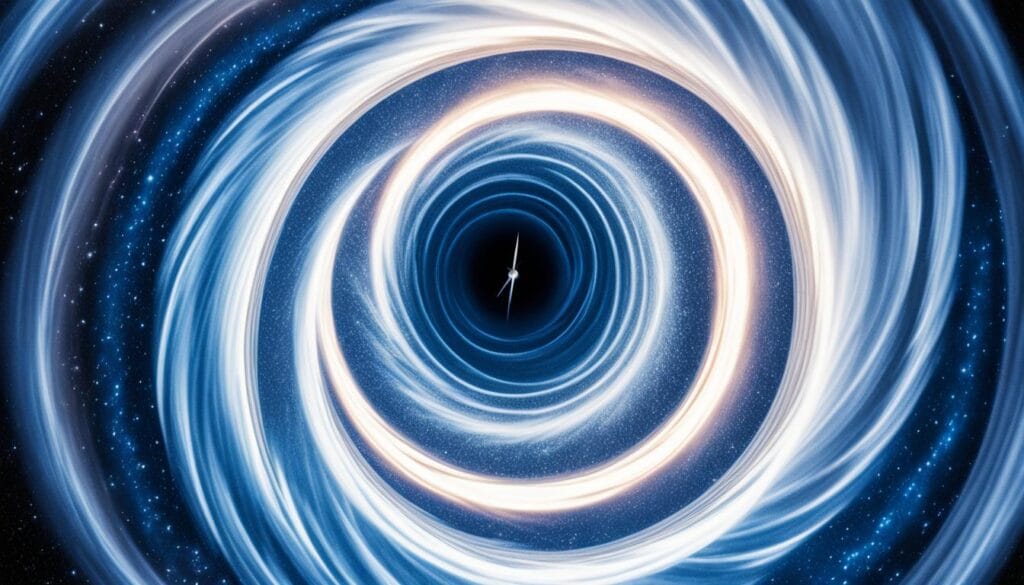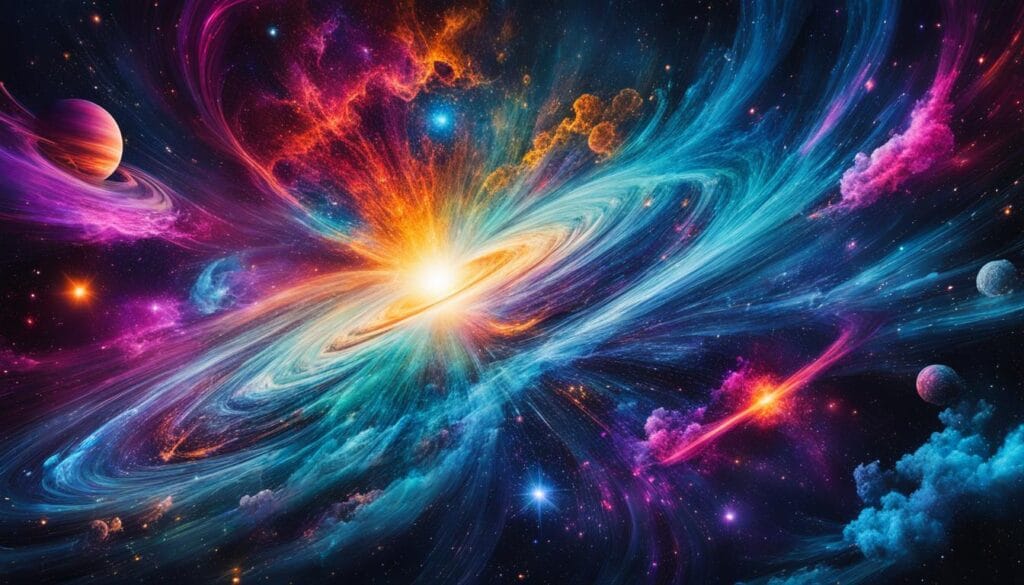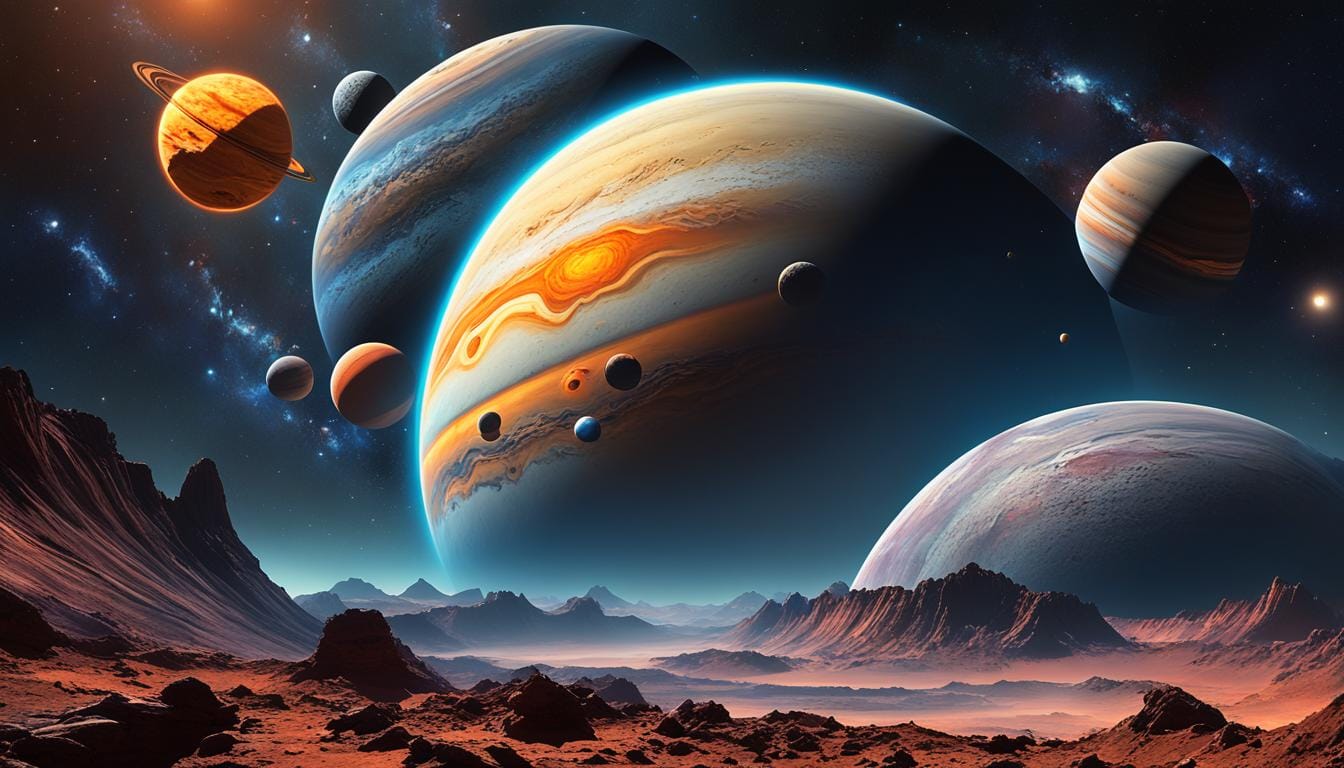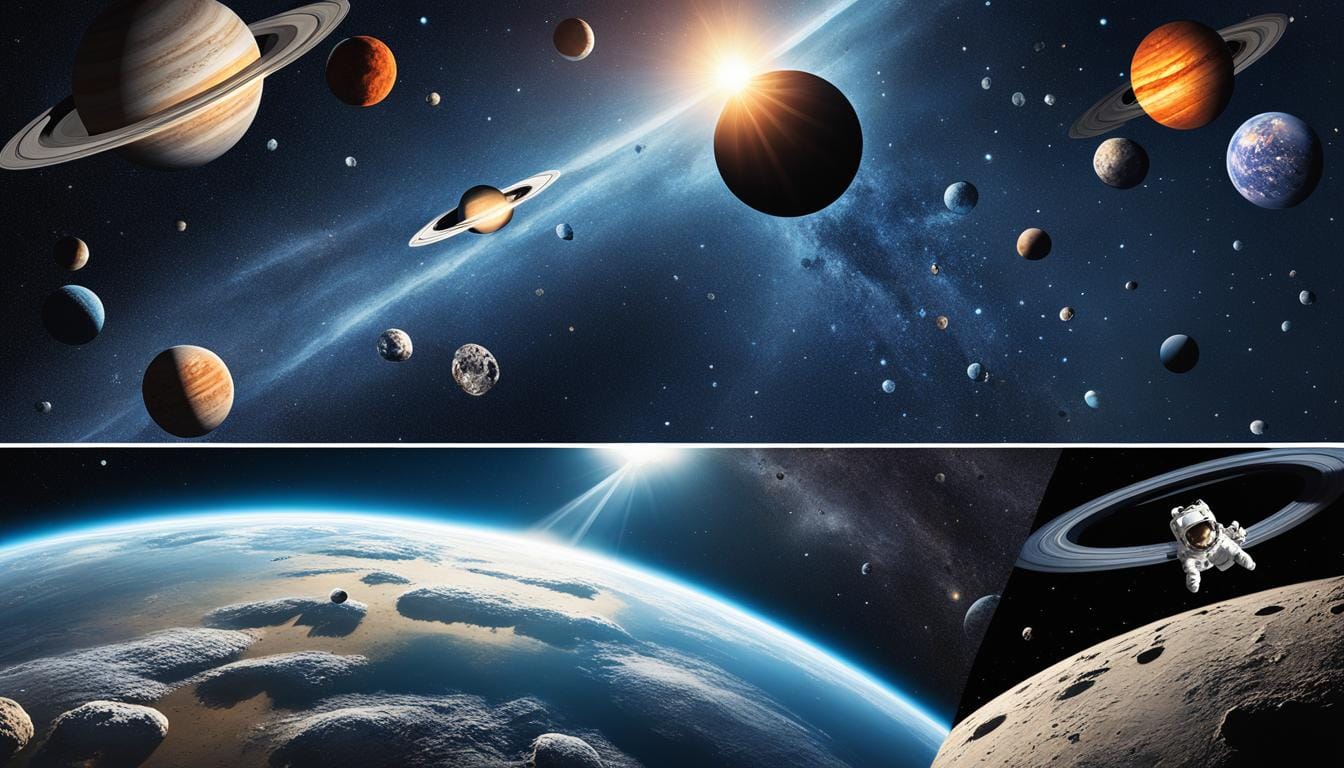The universe is full of mysteries. Questions range from the universe’s makeup to life’s origins and the search for alien life. Scientists are still trying to figure out many things. What secrets are hidden in space, and what puzzles need solving? Let’s explore the 10 most fascinating cosmic mysteries that keep scientists excited.
What if the universe’s secrets are closer than we think? As science advances, the chance to uncover the universe’s deepest secrets grows. Get ready for a journey of discovery where answers might be just a question away.
The Enigma of Time Travel
Time, a mysterious part of our universe, has always fascinated scientists and fans of science. The idea of traveling through time, once just in stories, is now being looked at by scientists. Einstein’s theory of relativity says time isn’t fixed, which makes exploring time travel possible.
From Wormholes to Cosmic Strings
Scientists have come up with different ways to travel through time, each with its own problems. Wormholes, which are tunnels in space-time, could let us go back and forth in time. But, we’re not sure if they work or how to use them. Cosmic strings, another idea, might also help us travel through time, but we don’t know much about them yet.
Time travel also brings up big problems, like the Grandfather Paradox. This says changing the past could stop us from being born, which doesn’t make sense. The Bootstrap Paradox makes us wonder where information comes from, adding to the puzzle of time.
Even with the big challenges, people are still drawn to the idea of time travel. The chance to see the past or future keeps us thinking and exploring. As we learn more about space-time, trying to figure out time travel is both exciting and confusing.

Getting to travel through time might be hard, but thinking about it has helped us understand the universe better. As we keep exploring, the mystery of time travel keeps us thinking and wondering about our place in the universe.
Unraveling the Composition of the Universe
The universe is a big mystery, with only 5% made up of the stuff we can see. The rest is dark matter and dark energy, which scientists don’t fully understand. They’ve been studying these mysterious parts for years, but they’re still a puzzle.
Cosmic inflation was a time when the universe grew really fast. It was so fast that it left a big mark on what the universe is like today. Scientists are trying to figure out what happened back then to understand our universe better.
They’re looking into leptogenesis to understand where matter came from. This idea talks about a new particle called the right-handed neutrino. It’s really hard to find because it’s so tiny and light.
Now, scientists have a new way to study leptogenesis. They’re looking at how stars and galaxies are spread out in space. They hope to find clues about where matter came from. This could help us understand the universe’s composition better.
| Key Statistic | Description |
|---|---|
| 95% | The percentage of the universe’s composition that is made up of dark matter and dark energy, which remain largely enigmatic. |
| 10 billion | The energy of the cosmic inflation, an era when the universe expanded at an exponentially accelerating rate, is believed to have been up to 10 billion times larger than any human-made collider. |
| H0 = 100h kms^−1Mpc^−1 | The Hubble parameter, which parameterizes the uncertainty in the expansion rate of the universe. |

The study “Probing Leptogenesis with the Cosmological Collider” offers a new way to solve the universe’s mysteries. By using observations, scientists hope to learn more about where matter came from. This could give us new insights into our universe.
Cosmic Mysteries: The Origin of Life
The origin of life on Earth is a big mystery in science. How did the first living things come from non-living matter? Scientists are trying to figure out how simple molecules turned into the building blocks of life. This is a deep and tricky puzzle for those studying origin of life, molecular evolution, and abiogenesis.
From Molecules to Living Entities
Scientists have been trying to understand how life started. They look at biochemical processes and complex systems to see how simple compounds could turn into more complex structures. This includes things like self-replicating RNA or DNA molecules. This step is key to figuring out how life began on our planet.
| Key Milestones in the Origin of Life | Timeline |
|---|---|
| Formation of basic organic compounds | 4.6 billion years ago |
| Emergence of self-replicating molecules | 4.2 billion years ago |
| First primitive cells with basic metabolism | 4 billion years ago |
| Appearance of more complex cellular life | 3.5 billion years ago |
Scientists are still working hard to understand how life started. They face the challenge of figuring out the complex molecular evolution and biochemical processes behind the first living things on Earth. This mystery is a big focus for researchers who want to know more about our existence.
The Quest for Extraterrestrial Intelligence
The search for extraterrestrial intelligence (SETI) is a fascinating scientific journey. It aims to answer the question: are we alone in the universe? As we explore space, finding out if there’s extraterrestrial life and if they can communicate with us has become crucial.
The COSMIC project is a big step forward in this search. It’s based at the Karl G. Jansky Very Large Array (VLA) in New Mexico. COSMIC can look through the VLA’s normal data for signs of extraterrestrial technology.
- COSMIC has looked at over 485,000 sources from 2 to 45GHz.
- The VLA Sky Survey maps the sky fast, checking 2000 sources per hour. In six months, COSMIC observed over 500,000 sources.
- COSMIC plans to cover 80% of the sky in two years, listing about 10 million radio sources.
- COSMIC can check millions of stars and could look at tens of millions more.
Dr. Chenoa Tremblay leads the COSMIC project, a big leap in finding extraterrestrial intelligence. It uses a fiber optic splitter, an FPGA cluster, and a CPU/GPU cluster. This lets COSMIC look for alien technology without slowing down the VLA’s usual work.
| Feature | Description |
|---|---|
| Data Collection | COSMIC has looked at over 485,000 sources from 2 to 45GHz. |
| Sky Mapping | The VLA Sky Survey maps the sky fast, checking 2000 sources per hour. In six months, COSMIC observed over 500,000 sources. |
| Mapping Goals | COSMIC plans to cover 80% of the sky in two years and list about 10 million radio sources. |
| Search Capacity | COSMIC can check millions of stars and could look at tens of millions more. |
COSMIC’s design is flexible and can be updated, making it valuable for years to come. As it grows, it might uncover new things that change how we see the universe and our role in it.
Decoding the Essence of Human Consciousness
Human consciousness is a fascinating topic for scientists and thinkers. It’s what makes us different from other animals and gives us our unique sense of self. Neuroscience and cognitive science are working hard to understand how our brain, mind, and identity are connected.
Brain, Mind, and the Self
Recent studies in neuroscience show that damage to the reticular activating system can cause a coma. This highlights how important this area is for keeping us conscious. The integrated information theory suggests that our brain’s ability to process information deeply creates consciousness.
Our understanding of consciousness has grown from ancient philosophers like Aristotle and Plato to modern thinkers like David Chalmers. They try to solve the “hard problem” of how brain processes create our subjective experiences. Descartes’ famous idea, “I think, therefore I am,” changed the way we see our self-awareness during the Renaissance.
As scientists keep exploring cognition and the brain-mind link, the mystery of human consciousness stays deep and complex. New ideas like panpsychism and quantum consciousness suggest that the answers might be in how we see reality itself.
The Enigmatic World of Dreams
Dreams have always fascinated us, sparking endless curiosity. They could be our deepest desires, fears, or just random brain activity during sleep. Researchers are still trying to figure out what dreams mean and why we have them.
Sigmund Freud, a famous psychoanalyst, had a big idea about dreams. He thought dreams let us see our hidden thoughts and feelings. He believed dreams were a way for our minds to deal with things we keep hidden.
Now, cognitive neuroscience offers a new view on dreams. This field says dreams help us remember things, process emotions, and solve problems. Dreams happen during REM sleep, when our brains are very active. They help mix new information with what we already know.
| Theories on the Function of Dreams | Key Aspects |
|---|---|
| Freudian Theory | Dreams as a window into the unconscious, expressing repressed desires and emotions |
| Cognitive Neuroscience Perspective | Dreams as a mechanism for memory consolidation, emotional processing, and problem-solving |
Scientists are still learning about dreams, bringing new ideas to light. From Freud’s ideas to modern neuroscience, studying dreams helps us understand our minds better. It shows how our dreams connect to our hidden thoughts and feelings.
The Matter-Antimatter Asymmetry Puzzle
The imbalance between matter and antimatter in the early universe is a big mystery. The Big Bang theory says matter and antimatter should have been created equally. But today, we see much more matter than antimatter.
Particle physics shows that matter and antimatter don’t behave the same. Particles and antiparticles change back and forth millions of times a second. This breaks the expected 50-50 chance of matter or antimatter decay.
Scientists are looking at how matter and antimatter act in high-energy collisions at the Large Hadron Collider. They want to find out why there’s so much more matter in the universe. The difference is huge, with about 5 to 10 times more matter than antimatter expected.
| Statistic | Value |
|---|---|
| Survival rate of matter particles over antimatter particles | About one particle per billion |
| Observed imbalance of matter and antimatter in the universe | 5 to 10 baryons over photons |
| Asymmetry in CP-violation sensitive quantities at the LHCb experiment | Up to 20% |
There are many theories trying to explain why matter won over antimatter. Ideas include matter and antimatter separating early on or the idea of a mirror anti-universe. Researchers in particle physics and cosmology are working hard to figure out what happened in the early universe.
The Multiverse Hypothesis: Are There Parallel Universes?
The idea of a multiverse, where parallel universes exist with ours, has caught the attention of scientists, thinkers, and the public. This theory, based on theories in cosmology and quantum mechanics, says our universe might be just one of many. It’s a mind-bending idea that has sparked interest across the globe.
Back in the early 1900s, physicist Hugh Everett III came up with the “many-worlds interpretation” of quantum mechanics. He thought that every time a choice is made, the world splits into new universes, each with its own path. This idea has sparked a lot of debate and curiosity.
Later, theories like the cosmological multiverse theory suggested that rapid expansion, such as cosmic inflation, could create new “bubble universes” beyond what we know. The fine-tuning problem, brought up by physicist Brandon Carter, also made people wonder why our universe is so perfect for life. This might hint at the existence of a multiverse.
Today, the idea of the multiverse is a hot topic among scientists. Some see it as a logical next step in understanding the universe. Others are skeptical, saying it’s not proven and could undermine science.
Despite the debate, scientists keep exploring the multiverse. They look for clues in cosmic microwave background radiation and at places like the Large Hadron Collider. The idea of the multiverse makes us think about big questions like reality, consciousness, and where the universe came from.
As we learn more about the universe, the multiverse idea keeps us thinking. It makes us wonder about the existence of parallel realities and the secrets beyond what we know.
Tackling Global Warming and Carbon Emissions
Global warming and the need to reduce carbon emissions are big concerns worldwide. Human actions, like using a lot of fossil fuels, farming a lot, and not using land well, have raised greenhouse gases in the air. This has happened over the last 250 years.
The IPCC says it’s very likely that people have warmed the planet since 1750. This warming is almost certain. It’s causing big problems, like rising sea levels, ocean acid, and more extreme weather.
We need a strong plan to fight climate change. Switching to renewable energy like solar, wind, and geothermal is key. New tech in storing energy, smart grids, and capturing carbon can also help.
Planting more trees and managing land well can help with deforestation and climate change. Choosing paper straws over plastic is a small step towards being more eco-friendly.
Stopping global warming and cutting carbon emissions needs global action. Governments, companies, and people must work together. They need to make good environmental policies, invest in clean energy, and live more sustainably for a better future.
Harnessing the Power of the Sun
The sun is like a huge nuclear reactor at our solar system’s center. It’s key to solving the global energy crisis. With the need for clean energy growing, solar power is becoming more important. The solar energy market is growing fast, and solar panels are getting more efficient.
This means the sun’s energy could change how we power our world.
Renewable Energy and Nuclear Fusion
Solar energy is getting more popular, growing by 20% each year for the last five years. Experts predict a 30% increase in solar installations in homes soon. This is because solar energy has gotten cheaper by 50% in the past ten years.
This makes it a cheaper and greener choice compared to old energy sources.
At the same time, scientists are working on nuclear fusion. This is the same process that makes the sun work. They aim to create fusion reactors that can make clean energy by copying the sun’s method.
| Solar Energy Metrics | Percentage Change |
|---|---|
| Solar Energy Market Growth | 20% annual growth |
| Solar Panel Efficiency Improvement | 15% increase in the last decade |
| Solar Energy Adoption | 5% of global energy consumption projected within 3 years |
| Solar Job Market | 10% increase in job opportunities in the upcoming year |
| Solar Energy Cost Reduction | 50% decrease in the last decade |
| Solar Energy Investment | 25% increase in global investment compared to the previous year |
| Solar Energy Storage Efficiency | 30% increase in grid-scale solar storage systems |
As we move towards a greener future, the sun’s energy and nuclear fusion could be key. They could change the way we think about energy, leading to a cleaner and more stable energy future.
Qualia, Entanglement, and Consciousness: Keys to Cosmic Mysteries
Exploring the universe’s mysteries, we find qualia, entanglement, and consciousness as key ideas. Qualia help us understand our experiences in a new way. Entanglement shows how everything might be connected. And consciousness could be the answer to big questions about life and the universe.
Trying to break down complex things into simple parts hasn’t fully solved these mysteries. A holistic view, considering consciousness and our subjective experiences, might help. By looking at how qualia, entanglement, and consciousness work together, we can better understand the universe.
Quantum physics shows us how everything is connected. It tells us that particles can affect each other instantly, no matter the distance. This idea, along with qualia, opens new doors in understanding the universe.
| Concept | Description | Significance |
|---|---|---|
| Qualia | The subjective and qualitative aspects of our experiences, such as the sensation of color or the taste of chocolate. | Provides a unique perspective on the nature of reality, challenging the dominant reductionist and objective worldview. |
| Entanglement | The phenomenon in quantum physics where particles become inextricably linked, with their properties influencing each other. | Suggests a fundamental interconnectedness in the universe, challenging our traditional notions of causality and space-time. |
| Consciousness | The enigmatic experience of being aware, which may hold the key to understanding the origins of life and the universe. | Suggests that consciousness may play a crucial role in shaping our understanding of the cosmos, going beyond the limitations of reductionist approaches. |
By looking at the world holistically, we might find new ways to solve the big mysteries. This could lead to new discoveries and a deeper understanding of our universe.
The Wrong Questions: Rethinking Reductionism
For over 2,000 years, scientists have mainly used the reductionist approach. They believe everything is made up of tiny parts, like molecules and atoms. But this method hasn’t fully solved some big mysteries of the universe.
Now, scientists are questioning the reductionist model. This comes after the Large Hadron Collider confirmed the standard model of particle physics. Reductionism has been successful, breaking down complex things into simpler parts. But big mysteries like dark energy, dark matter, and the measurement problem in quantum mechanics are hard to solve with this method.
This has led to a new interest in a holistic approach. Scientists are looking at big ideas like qualia, entanglement, and consciousness. They think these ideas are key to understanding the universe and complex phenomena.
Embracing Wholeness and Complex Systems
The limits of reductionism are clear now. Breaking down systems and using fundamental theories to explain everything has its limits. Ideas like grand unified forces, supersymmetry, and string theory haven’t solved the big mysteries yet.
A holistic approach might be the answer. It looks at the big picture and the connections between things. This could lead to new discoveries and research paths.
As we see the flaws in the old way of thinking, scientists need to rethink their questions. They should look for new ways to understand the interconnected nature of the cosmos. This could help solve the cosmic mysteries we’ve been trying to figure out.
Evolution’s Origins: A Holistic Perspective
The origins of evolution have always fascinated scientists. They used to focus mainly on genes and chemicals. Now, more researchers want to look at the big picture, including the universe’s connections and how consciousness affects evolution.
Recent studies have shown how complex and changing the universe is. Edwin Hubble’s work in the late 1920s showed that stars and galaxies move away from us, meaning the universe is getting bigger. Scientists think the universe is between 10 billion and 15 billion years old. The Milky Way and our solar system are much younger, around 9 to 16 billion and 4.54 billion years ago, respectively.
It’s thought that life on Earth started as early as 3.5 billion years ago. Some believe there could have been life even before that. The idea of an “RNA world” before DNA and proteins has come up, where RNA was the main player. Also, experiments have shown how the basic parts of life could have formed by chance.
These discoveries make us rethink how life and complex systems started. Looking at the universe as a whole, including consciousness and self-organizing patterns, could help us understand reality better. This could lead to a deeper understanding of evolution and the universe.
As we delve deeper into the universe, combining different views and accepting complexity might help us figure out evolution’s origins and the nature of reality.
Cosmic Mysteries and the Nature of Reality
Exploring cosmic mysteries takes us to the edge of what we know about reality. We face questions that challenge our understanding of the universe and our role in it. These questions push us to see the cosmos and our place in it in a new way.
At the core, we find the mystery of reality. Quantum physics has changed how we see cause and effect, showing us a world of tiny particles that act strangely. Phenomena like quantum entanglement and superposition suggest a deep connection we can’t fully grasp.
Looking at these mysteries holistically might help us solve them. By considering the role of consciousness and the universe’s complex connections, we can move past simple explanations. This lets us explore deeper into the metaphysical realms that shape reality.
| Cosmic Mysteries | Insights from Quantum Physics |
|---|---|
| The Enigma of Time Travel | Quantum entanglement and the blurring of space-time |
| The Composition of the Universe | The elusive nature of dark matter and dark energy |
| The Origin of Life | The role of quantum effects in the emergence of life |
| The Essence of Human Consciousness | The quantum nature of the mind and its implications |
By diving into the universe’s complexity and quantum physics, we might grasp the nature of reality better. This journey of discovery could broaden our views, making us question our basic beliefs. It could lead to a new, more complete way of seeing the world.
Conclusion
Reflecting on the cosmic mysteries we’ve covered, it’s clear the quest for scientific discovery is ongoing and thrilling. Modern astronomy, astrophysics, and cosmology have greatly expanded our understanding of the universe. Yet, many questions still puzzle us.
Technologies like the James Webb Space Telescope have opened new doors to understanding. They show us distant stars, ancient galaxies, and the secrets of dark matter. These findings have grown our knowledge and motivated new scientists to explore more.
The heart of scientific exploration is keeping an open, curious mind. It’s about questioning what we know and seeing the universe in a new way. By looking at the universe’s complexity, we might find answers that change how we see everything. As we keep exploring, the future of space discovery is full of exciting possibilities. It invites us to keep searching and solving the universe’s biggest mysteries.


